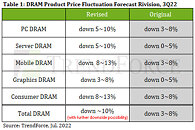With the course of the COVID-19 pandemic constantly changing, China is sticking with its "Dynamic Zero-COVID Policy" and has been slow to lift the lockdown on its cities that have been recently affected by the outbreaks of the disease. Hence, the manufacturing industries of the major Chinese cities are facing delays in the resumption of normal operation, and a production gap has emerged in 2Q22. For the electronics ODMs, this production gap will be difficult to bridge in 2H22. Additionally, the ongoing global inflation is keeping prices of goods at a very high level, and this trend will dampen the peak-season demand surge during the second half of the year. The effect of the inflationary pressure has been especially noticeable in the demand for consumer electronics such as smartphones, notebook computers, and tablet computers. This, in turn, is also impacting the MLCC market in terms of demand and inventory. Currently, the general inventory level has risen above 90 days for MLCCs of all sizes. Therefore, TrendForce forecasts that prices of consumer-spec MLCCs will fall further by 3-6% on average in 2H22.
On the other hand, demand remains fairly strong in application segments such as high-performance computing solutions (which include servers), networking equipment, industrial automation solutions, and energy storage systems. Furthermore, IDMs in the semiconductor industry will be adjusting the allocation of production capacity as the market for consumer electronics continues to experience a slowdown in 2H22. As a result, the undersupply situation for certain ICs will ease. Moreover, demand will be propped up in the high-end segment of the MLCC market and other application segments (e.g., automotive electronics and industrial equipment). All in all, thanks to the demand related to automotive electronics, servers, networking equipment, etc., TrendForce forecasts that the annual total MLCC shipments will increase by 2% YoY to around 2.58 trillion pieces for 2022.














































